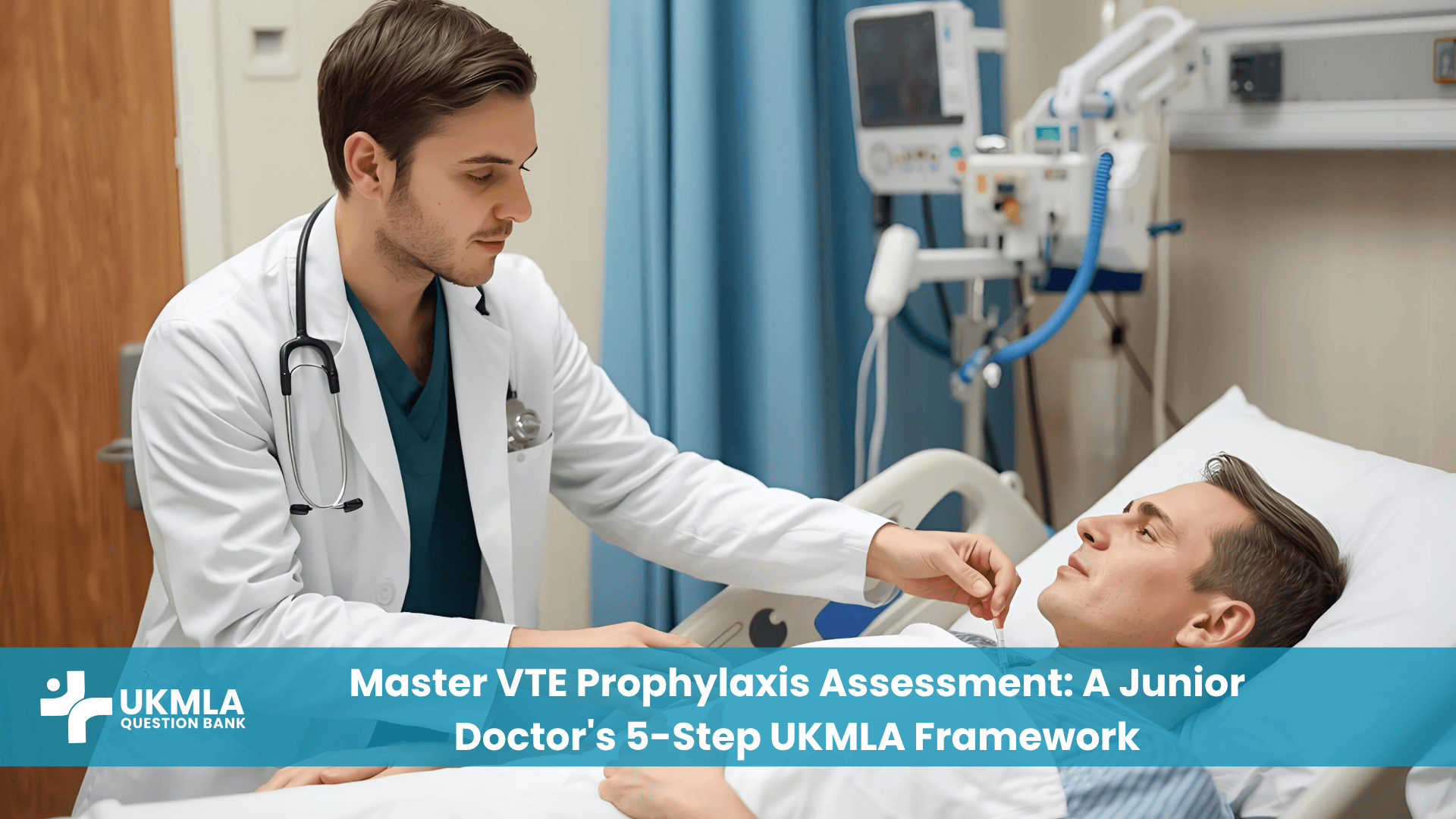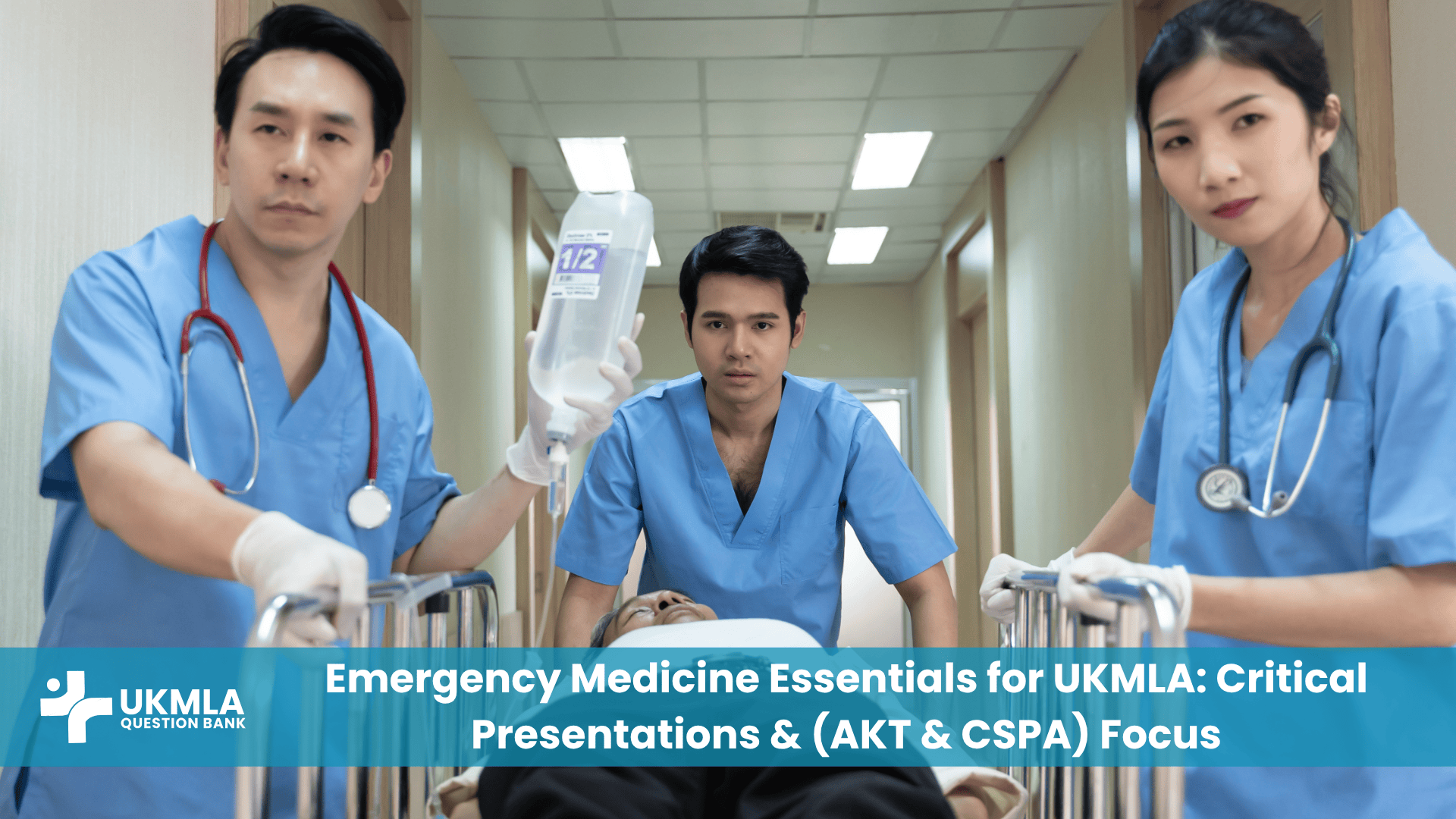Introduction
VTE prophylaxis assessment UKMLA scenarios represent one of the most fundamental and frequently tested patient safety competencies for foundation doctors. That moment on the ward round when your consultant asks, “Has this patient got VTE prophylaxis?” can trigger anxiety—what if you miss a crucial risk factor? What if you prescribe anticoagulation to someone with bleeding risks? This exact uncertainty is why VTE assessment features prominently in both clinical practice and UKMLA examinations.
Every year in the NHS, hospital-acquired venous thromboembolism causes significant patient harm, with approximately 25,000 preventable deaths annually. As an FY1, your systematic approach to VTE risk assessment serves as the first line of defense against these preventable complications. This guide provides a practical 5-step framework that transforms complex guidelines into actionable steps you can apply immediately during ward rounds and in your UKMLA assessments.
Table of Contents
ToggleKey Takeaways
✓ Systematic VTE risk assessment prevents life-threatening complications
✓ Five essential steps ensure comprehensive patient evaluation
✓ Understanding bleeding risk balances safety with prophylaxis benefits
✓ Clear documentation demonstrates clinical competence and patient safety
✓ Regular reassessment adapts to changing patient conditions
Understanding VTE Risk in Hospitalized Patients
The Scope of the Problem: Statistics and Impact
Venous thromboembolism remains the leading cause of preventable hospital death in the UK. Understanding the magnitude of this problem reinforces why VTE prophylaxis assessment UKMLA competencies are so heavily emphasized according to NICE Guidelines:
60% of all VTE cases occur during or following hospital admission
1 in 10 hospital deaths are attributable to hospital-acquired thrombosis
40% of medical inpatients and 60% of surgical patients have multiple VTE risk factors
Appropriate prophylaxis reduces VTE risk by 50-60%
“The most common error I see in junior doctors’ VTE assessments isn’t forgetting to prescribe—it’s failing to appreciate the cumulative effect of multiple moderate risk factors. Three ‘moderate’ risks often equal one ‘high’ risk that demands aggressive prophylaxis.” — Consultant Haematologist
High-Risk Patient Groups and Special Considerations
Certain patient populations demand particular attention during your VTE prophylaxis assessment UKMLA practice:
Orthopaedic surgery patients – especially hip and knee replacements
Major cancer surgery patients and those receiving chemotherapy
Critical care patients with prolonged immobility
Stroke patients with limb weakness
Pregnant and postpartum women with additional risk factors
The 5-Step Framework for Comprehensive VTE Assessment
Step 1: Identify Patient-Specific Risk Factors
Begin every assessment with a systematic review of the patient’s risk factors. Use the “THROMBOSIS” mnemonic as your mental checklist:
T – Trauma or surgery (major procedures)
H – Hospitalization (especially >3 days)
R – Reduced mobility (bed-bound >72 hours)
O – Older age (>60 years)
M – Malignancy (active or recent treatment)
B – Blood disorders (inherited thrombophilias)
O – Obesity (BMI >30)
S – Serious medical illness (heart failure, COPD, IBD)
I – Previous history of VTE or family history
S – Smoking and other vascular risk factors
Surgical vs Medical Patient Considerations
Surgical patients require particular attention to the type and duration of surgery, while medical patients need assessment of their acute illness severity and mobility status.
Calculating the Padua Prediction Score
For medical patients, use the Padua Prediction Score to quantify risk:
Very high risk: Score ≥4 – pharmacological prophylaxis indicated
Low risk: Score <4 – consider mechanical prophylaxis only
Step 2: Assess Bleeding Risk Systematically
Before prescribing anticoagulation, you must exclude contraindications. Use the “BLEEDING” checklist:
B – Bleeding disorders (known coagulopathies)
L – Liver disease (severe impairment)
E – Elderly with falls risk
E – Emergency surgery or trauma
D – Drugs (antiplatelets, NSAIDs, anticoagulants)
I – Intracranial pathology (recent bleed, stroke)
N – Neurosurgery or spinal procedures
G – Gastrointestinal bleeding (active or recent)
Contraindications to Pharmacological Prophylaxis
Absolute contraindications include:
Active bleeding
Severe thrombocytopenia (<50×10⁹/L)
Recent haemorrhagic stroke
Major regional anaesthesia (e.g., spinal/epidural within 4-12 hours)
Step 3: Select Appropriate Prophylaxis Modalities
Based on your risk-benefit assessment, choose from these options. For comprehensive prescribing guidance, see our guide on Prescribing Safely for the UKMLA & PSA.
Mechanical Prophylaxis Options
Anti-embolism stockings (AES) – ensure proper sizing and no contraindications (peripheral arterial disease, neuropathy)
Intermittent pneumatic compression (IPC) devices – ideal for surgical patients and those with bleeding risks
Foot impulse devices – alternative for patients who cannot tolerate stockings
Pharmacological Agents
Understanding pharmacology is crucial – review Master High-Yield Pharmacology for UKMLA for deeper knowledge.
Low Molecular Weight Heparin (LMWH) – enoxaparin, dalteparin (first-line for most patients)
Fondaparinux – alternative for heparin-induced thrombocytopenia
Direct Oral Anticoagulants (DOACs) – rivaroxaban, apixaban (specific surgical populations)
Step 4: Document Your Assessment and Plan
Comprehensive documentation should include:
VTE risk score and individual risk factors identified
Bleeding risk assessment and contraindications considered
Prophylaxis method chosen with rationale
Planned review date and duration
Step 5: Plan Reassessment and Duration
VTE risk is dynamic—reassess:
Daily during acute hospital stay
At discharge to consider extended prophylaxis
After significant clinical changes (new immobility, surgery, bleeding)
VTE Risk Assessment and Prophylaxis Options
| Risk Category | Patient Examples | Recommended Prophylaxis | Duration |
|---|---|---|---|
| Very High Risk | Major orthopaedic surgery, multiple trauma, critical care patients | LMWH + mechanical methods | 4-5 weeks (orthopaedic), until mobile |
| High Risk | Major general surgery, cancer surgery, medical patients with reduced mobility + infection | LMWH or fondaparinux | Until discharge or mobile |
| Moderate Risk | Minor surgery, medical patients with single risk factor | Mechanical methods or LMWH | Until mobile |
| Low Risk | Ambulatory patients, minor procedures with early mobilisation | Early ambulation only | N/A |
LMWH Dosing Guide for VTE Prophylaxis
| Medication | Standard Prophylaxis Dose | Renal Adjustment (eGFR <30) | Special Considerations |
|---|---|---|---|
| Enoxaparin | 40mg OD | 20mg OD or avoid | Monitor anti-Xa in obesity/renal impairment |
| Dalteparin | 5000 units OD | 2500 units OD | Preferred in renal impairment |
| Tinzaparin | 4500 units OD | 3500 units OD | Once daily dosing |
Special Population Considerations
Renal Impairment and VTE Prophylaxis
Patients with renal impairment require careful consideration. As covered in our guide to Master Prescribing in Renal Failure, several key principles apply:
Enoxaparin accumulates in renal impairment – consider dose reduction or alternative
Dalteparin is preferred in moderate-severe renal impairment
Fondaparinux is contraindicated in eGFR <30 mL/min
Monitor anti-Xa levels in severe renal impairment if using LMWH
Pregnancy and Postpartum Patients
Pregnant women have a 5-10 fold increased VTE risk:
LMWH is safe throughout pregnancy (does not cross placenta)
Warfarin and DOACs are contraindicated in pregnancy
Prophylaxis continues for 6 weeks postpartum in high-risk women
Consider thromboprophylaxis from first trimester in women with previous VTE
Cancer Patients and Extended Prophylaxis
Cancer patients have particularly high VTE risks:
4-7 times higher VTE risk compared to non-cancer patients
Extended prophylaxis (4 weeks) after cancer surgery
Consider prophylactic LMWH during chemotherapy in high-risk patients
Regular platelet monitoring due to chemotherapy-induced thrombocytopenia
Common Clinical Scenarios and Solutions
The Post-Operative Orthopaedic Patient
Scenario: 68-year-old female post total hip replacement, BMI 32, no bleeding risks.
Assessment:
Very high risk (major orthopaedic surgery + obesity)
No bleeding contraindications
Requires aggressive pharmacological prophylaxis
Management:
Enoxaparin 40mg OD (consider 40mg BD if very high BMI)
Mechanical compression device until mobile
Extended prophylaxis for 35 days post-discharge
Document: “Very high VTE risk – major orthopaedic surgery + obesity. LMWH prophylaxis for 35 days as per NICE guidance.”
The Medically Ill Patient with Multiple Comorbidities
Scenario: 75-year-old with heart failure, COPD, and chest infection, bed-bound for 4 days.
Assessment:
Padua score ≥4 (age, heart failure, infection, immobility)
High VTE risk requiring pharmacological prophylaxis
Assess bleeding risk carefully
Management:
LMWH prophylaxis (dalteparin 5000 units OD)
Continue until mobile and infection resolved
Daily reassessment of bleeding risk and mobility
The Patient with Thrombocytopenia
Scenario: 55-year-old with chemotherapy-induced thrombocytopenia (platelets 35×10⁹/L).
Assessment:
High VTE risk (cancer, chemotherapy)
High bleeding risk (thrombocytopenia)
Pharmacological prophylaxis contraindicated
Management:
Mechanical prophylaxis only (IPC devices)
Monitor platelets daily
Consider pharmacological prophylaxis when platelets >50×10⁹/L
UKMLA Assessment Focus
AKT Question Patterns on VTE Prophylaxis
In the Applied Knowledge Test, VTE prophylaxis assessment UKMLA questions typically assess:
Calculation of Padua scores and risk stratification
Identification of bleeding risk contraindications
Appropriate prophylaxis selection for clinical scenarios
Duration of prophylaxis in special populations
Management of prophylaxis in renal impairment
CPSA Station Scenarios and Assessment Criteria
In clinical practical assessments, you might encounter:
Medication review station identifying missing VTE prophylaxis
Prescribing station requiring appropriate LMWH selection
Patient explanation station discussing prophylaxis rationale
Documentation station demonstrating comprehensive assessment
For more on professional standards, see Professionalism and Patient Safety in the UKMLA CPSA.
Documentation Essentials
Proper documentation is crucial for patient safety and your professional development. Key elements include:
What to Include in Your Clinical Notes
Comprehensive VTE documentation should follow this structure:
VTE Risk Assessment:
Padua score: [calculated score]
Key risk factors: [list identified factors]
Overall risk category: [low/medium/high/very high]
Bleeding Risk Assessment:
Bleeding risk factors: [list any identified]
Contraindications to pharmacological prophylaxis: [present/absent]
Prophylaxis Plan:
Pharmacological: [drug, dose, frequency] or [not indicated]
Mechanical: [type of device/stockings] or [not indicated]
Duration: [specify time period or review criteria]
Next assessment: [date/time for review]
Electronic Health Record Best Practices
Use structured VTE assessment tools if available in your EPR
Ensure prophylaxis prescriptions are clear and unambiguous
Set automatic stop dates for time-limited prescriptions
Document reasons for any deviation from guidelines
VTE Prophylaxis Quick Reference Guide
| Situation | First Choice | Alternatives | Key Considerations |
|---|---|---|---|
| General Medical | LMWH (enoxaparin 40mg OD) | Fondaparinux 2.5mg OD | Calculate Padua score, assess bleeding risk |
| Major Orthopaedic | LMWH (enoxaparin 40mg OD) | Rivaroxaban 10mg OD | Extended duration (35 days), combined with mechanical |
| Renal Impairment | Dalteparin 5000 units OD | Reduced dose enoxaparin | Monitor anti-Xa if eGFR <30 |
| High Bleeding Risk | Mechanical methods only | Graduated compression stockings | Reassess daily for bleeding risk improvement |
| Cancer Patients | LMWH (standard dose) | Fondaparinux | Extended prophylaxis post-discharge, monitor platelets |
Avoiding Common Pitfalls
Under-prescribing in High-Risk Patients
The most common error is failing to recognize cumulative risk factors:
Three moderate risks = one high risk
Don’t underestimate obesity – BMI >30 is a significant independent risk factor
Cancer patients always need careful assessment – even ambulatory patients
Medical patients can be higher risk than surgical patients – don’t assume otherwise
Over-prescribing in Bleeding Risk Patients
Balancing thrombosis and bleeding risks requires judgment:
Thrombocytopenia (<50) = avoid pharmacological prophylaxis
Recent bleeding = reassess daily
Elderly with falls risk = consider mechanical methods first
Multiple antiplatelets = increased bleeding risk
Failure to Reassess
VTE risk is dynamic—common reassessment failures include:
Not reviewing at discharge for extended prophylaxis needs
Forgetting to stop prophylaxis when risks resolve
Not adjusting for clinical deterioration (new immobility, surgery)
Ignoring changing bleeding risk (developing thrombocytopenia, AKI)
Frequently Asked Questions (FAQ) about VTE Prophylaxis Assessment
The Padua score assigns points to risk factors: active cancer (3), previous VTE (3), reduced mobility (3), thrombophilia (3), recent trauma/surgery (2), age ≥70 (1), heart/respiratory failure (1), acute MI/ischaemic stroke (1), acute infection/rheumatic disorder (1), obesity BMI ≥30 (1), ongoing hormonal treatment (1). A score ≥4 indicates high risk requiring pharmacological prophylaxis.
Duration depends on the surgery type: major orthopaedic surgery (hip/knee replacement) requires 35 days of prophylaxis; major cancer surgery typically needs 4 weeks; other major surgeries generally continue until discharge or full mobility returns. Always consult specific guidelines for the procedure and patient factors.
In moderate-severe renal impairment (eGFR <30 mL/min), prefer dalteparin over enoxaparin as it has less renal accumulation. Reduce enoxaparin to 20mg daily if used, or consider mechanical prophylaxis if high bleeding risk. Monitor anti-Xa levels in severe impairment and consult pharmacy or haematology for complex cases.
Absolute contraindications include active bleeding, severe thrombocytopenia (platelets <50×10⁹/L), recent haemorrhagic stroke, major active gastrointestinal bleeding, and within 4-12 hours of major regional anaesthesia (spinal/epidural). Relative contraindications require individual risk-benefit assessment.
Low molecular weight heparin (LMWH) is safe throughout pregnancy as it doesn’t cross the placenta. Continue prophylaxis for 6 weeks postpartum in high-risk women. Warfarin and DOACs are contraindicated. Dose adjustments may be needed in pregnancy—consult local guidelines and obstetric teams.
Routine monitoring isn’t needed for standard prophylaxis doses in patients with normal renal function. However, monitor platelets for heparin-induced thrombocytopenia (days 5-14), renal function regularly, and anti-Xa levels in special populations (obesity, renal impairment, pregnancy). Always assess for bleeding signs.
Extended prophylaxis (2-5 weeks post-discharge) should be considered for: major orthopaedic surgery, major cancer surgery, multiple trauma patients, medical patients with persistent reduced mobility and cancer, and those with previous VTE. Use risk assessment tools and consult local guidelines.
For BMI >40, consider increased LMWH doses (enoxaparin 40mg BD) or anti-Xa monitoring. There’s no need to adjust for BMI 30-40 with standard prophylactic doses. Use ideal body weight for dosing calculations in extreme obesity and consult pharmacy for guidance.
Immediately stop LMWH and send for HIT antibodies if the platelet drop is >50% or occurs between days 5-14. Use mechanical prophylaxis instead. If HIT is confirmed, avoid all heparin products and consult haematology for alternative management (fondaparinux, argatroban).
Reassess daily during acute admission, at any significant clinical change (new immobility, bleeding, surgery), and definitely at discharge. Document each assessment clearly. Remember that a patient’s VTE and bleeding risks are dynamic throughout their hospital stay.
Conclusion: Your Next Steps
Mastering VTE prophylaxis assessment UKMLA requirements is not just about exam success—it’s about embedding patient safety practices that will protect countless patients throughout your career. The systematic 5-step approach ensures you never miss crucial risk factors while maintaining the essential balance between thrombosis prevention and bleeding risk.
Your Action Plan for Mastery:
Practice the 5-step framework with every patient you clerk
Use the memory aids (THROMBOSIS and BLEEDING mnemonics) until they become automatic
Review Prescribing Safely for the UKMLA & PSA for pharmacological principles
Consult the NICE VTE guidelines regularly until familiar
Create your personal VTE assessment checklist for quick ward reference



